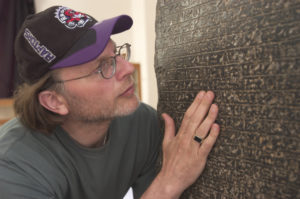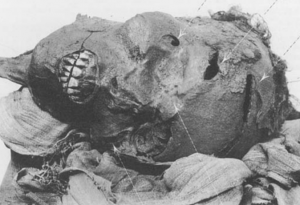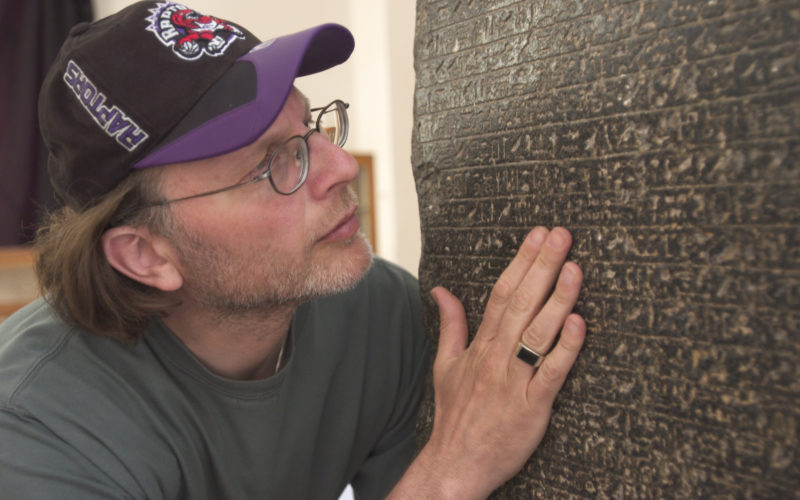Decoding the El Arish Stone – blog entry 2

In the past, I’ve summarized the content of the hieroglyphics on this granite, but I’ve now promised to go line by line through the entire inscription. I analyzed the first five lines here.
In summary, the first five lines seem to refer to the war the Egyptians conducted, around 1500 BCE/BC, under the command of Pharaoh Seqenenre Tao II – referred to on the El Arish stone by his divine name “Ra Harmakhis”. The battle was fought against an “Asiatic” people i.e., from the area of Canaan/Israel. This people are called “Amu” by the Egyptians on the granite. They are called “Hyksos” by modern scholars. Around 1,700 BCE, the Hyksos took over the delta i.e., “lower Egypt”, from the native Egyptians. For some 200 years, Egyptians and Hyksos lived next to each other in an uneasy truce. Then, the Egyptian Pharaohs decided to re-conquer the delta and drive out the Hyksos.
Under Seqenenre Tao II, the Egyptians from the south attacked north into the delta. Things did not fare well for them. The Hyksos are credited with bringing chariot technology into Egypt. The El-Arish stone describes how Seqenenre Tao II was defeated in battle and killed. Archaeologically, Seqenenre Tao II’s mummy has been found. He is on display at the Cairo Museum. He seems to have fallen off a chariot, sustaining bodily injuries. His head is clearly smashed by Hyksos axes. This battle of Egyptian liberation from Hyksos rule set the stage for the Biblical Exodus.

The El Arish stone describes how Seqenenre was replaced by his son, the divine “Shu”. We know from the historical record that this was Pharaoh Kamose.
According to the El Arish inscription, the divine “Shu”, who we identify with Pharaoh Kamose, withdrew the defeated Egyptian army to a place called At-Nebes. He then reorganized his army and once again attacked the Hyksos in lower Egypt, the scene of the Biblical Exodus.
This is what lines 6-18 say:
“6. His majesty, Shu [Kamose]…[proceeded] to his palace/residence in Pi-Yarit. This is where the royal burial places of At-Nebes were situated….7. …Like Heaven resting on its four pillars, it is here that Pi-Soped was rebuilt for his majesty, Shu [i.e., Kamose]. This was the temple to which Shu was most dedicated. 8. It was purposely placed on a south-north, west-east axis. The temple was dedicated….
9. … all of existence. There were eight chapels on the right, eight on the left and eight in the courtyard of the god Akhit Jabtit. This temple….10. Was dedicated to Shu in his divine name of Sepd, lord of the East.
The chapels faced each other. The residences [belonged?] to the…11. Great council of the gods [Enneade], to the small council of the gods, to the gods who attend to Ra and to the gods…12. Who attend to Shu. With respect to all these, the sanctuaries were constructed at [At-Nebes?] and encircled Shu’s temple. This temple faced east, facing the rising sun and the inhabitants…
13. …Temples – where each nome [district] was represented. In case any of the nomes got into trouble, this plan would be put into effect for….14. …Nebes was on the north but it faced the south. The temples of the gods that were in the territory [of At-Nebes?]….15. Faced the east. A pool was on the north side, a great thoroughfare ran in front of the temple reaching all the way to Pi-Yarit….
16. Pi-Yarit represented the face of Ra. With his staff, Shu [a.k.a Pharaoh Kamose] …17. …touched upon the [ground?]…and it became a sacred place in At-Nebes. It’s southern face represented the face of Pi-Yarit. Neither gods, nor goddesses, nor men, nor animals entered the sacred precinct to learn …18. its mysteries.”
What we have here is nothing less than the lead-up to the Exodus. The context is a civil war between north and south in Egypt. The indigenous Pharaohs of the south attacked the northern Asiatic/Canaanite rulers and got soundly defeated. The Pharaoh who initiated the conflict died in battle. His son ascended to the throne. The new Pharaoh immediately did two things: he withdrew his army and he reassembled it by rededicating himself and his troops to the Egyptian gods.
Like Moses, this Pharaoh who we identify with Kamose carried a “staff”, marking with it a sacred place within a newly constructed temple. Like Moses after the Exodus, according to the El Arish granite, Kamose constructed a religious center for his cult. Notice the god names these Pharaohs took i.e., Ra Harmakhis and Shu are associated with the Delta i.e., the north, not the south. They are associated with Heliopolis, not Thebes. Meaning, these Pharaohs are already declaring their intended rule of the north. Their god names, by definition, are a declaration of war on the Hyksos rulers of the Delta, the Biblical “Goshen”.
The El Arish “Naos” i.e., a shrine meant for the Holy of Holies of a temple, gives precise measurements for Kamose’s sacred structure: 20 cubits in height, 190 cubits in length and 110 cubits in width. Compare with the Biblical account (Exodus 27:9) of the outside enclosure of the Israelite tabernacle which was 5 cubits in height, 100 cubits in length and 50 cubits in width. What we see is a very similar structure; the Egyptian one being slightly bigger to accommodate residences for the “council of the gods” i.e., the priesthood and the political elite.
This section ends with a description of the Egyptian “Holy of Holies”, where no one but the divine Pharaoh could enter to learn its secrets or “mysteries”. The next section, which we will deal with next week, deals with the reengagement of the armies and the creation of the political and military conditions which would lead to the Israelite Exodus.
See also my latest blog in the Times of Israel – The passing of Paco de Lucía, flamenco… and the expulsion of the Jews!

